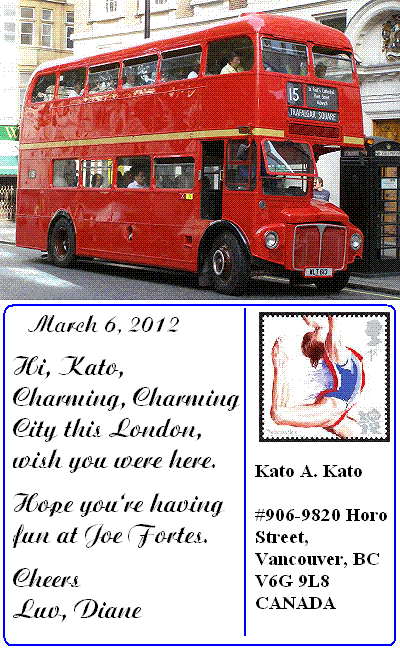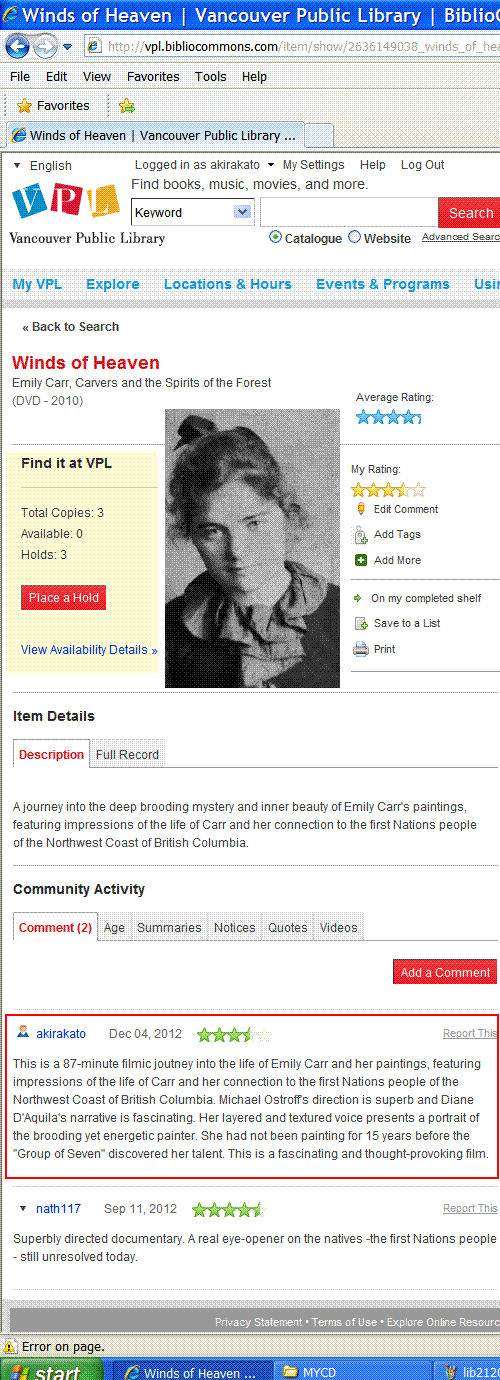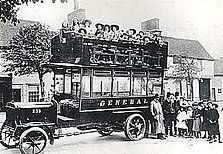Dream Dream Dream (PART 2 OF 3)

So you read the autobiography of Emily Carr, didn't you?

Yes, I did. The horse-drawn omnibus reminds me of the postcard you sent me the other day.

(postcd2.gif)

... and the "beet-root and lettuce" salad definitely makes you shop beet-roots at Safeway in my dream.

But how come you read her autobiography?
Well ... I happened to view her DVD.

(lib21206c.gif)
■"The Actual Catalogue Page"

The 87-minute filmic joutney into the life of Emily Carr and her paintings interested me greatly so much so that I looked into her autobiography.
Emily Carr
(December 13, 1871 – March 2, 1945)

(carr04.jpg)
She was a Canadian artist and writer heavily inspired by the indigenous peoples of the Pacific Northwest Coast.
One of the first painters in Canada to adopt a modernist and post-impressionist painting style, Carr did not receive widespread recognition for her work until later in her life.
As she matured, the subject matter of her painting shifted from aboriginal themes to landscapes, and in particular, forest scenes.
As a writer, Carr was one of the earliest chroniclers of life in British Columbia.
Born in Victoria, British Columbia, in 1871, the year British Columbia joined Canada, Emily Carr was the second-youngest of six children born to English parents Richard and Emily (Saunders) Carr.
The Carr home was on Birdcage Walk, (now Government Street) in the James Bay district of Victoria, a short distance from the legislative buildings (nicknamed the 'Birdcages') and the town itself.
<iframe width="420" height="315" src="http://www.youtube.com/embed/NhF_TcREdkU" frameborder="0" allowfullscreen></iframe>
Emily was taught in the Presbyterian tradition, with Sunday morning prayers and evening Bible readings.
Emily's father encouraged her artistic inclinations, but it was only in 1891, after her parents' deaths, that Carr pursued her art seriously.
Carr attended the San Francisco Art Institute for two years (1890–1892) before returning to Victoria.
In 1899 Carr traveled to London where she studied at the Westminster School of Art.
She traveled also to a rural art colony in St Ives, Cornwall, returning to British Columbia in 1905.
Carr took a teaching position in Vancouver at the 'Ladies Art Club' that she held for no longer than a month — she was unpopular amongst her students due to her rude behaviour of smoking and cursing at them in class, and the students began to boycott her class.
In 1927 Carr herself traveled east, timing her journey so that she would be able to meet members of the Group of Seven, at that time Canada's most recognized modern painters.
Lawren Harris of the Group became a particularly important support: "You are one of us," he told Carr, welcoming her into the ranks of Canada's leading modernists despite her own self-deprecating attitude.
The encounter changed the direction of Carr's artistic life, reinvigorating her sense of purpose and ending her artistic isolation of the previous 15 years.
Group of Seven
<iframe width="420" height="315" src="http://www.youtube.com/embed/zQx0WoC20i0" frameborder="0" allowfullscreen></iframe>
Source: "Emily Carr"
Free encyclopedia "Wikipedia (Wikipedia)"

So you're fascinated by the brooding yet energetic painter, aren't you?

Yes, I am.
Did you find anything important at all?
Oh yes, she had never been married. This is the big difference between you and Emily.
Kato, you had such a foolish dream. Don't confuse realty with your dream.

【Himiko's Monologue】

Wow!
I wish I could visit London and ride the red double-decker bus.
Buses have been used on the streets of London since 1829, when George Shillibeer started operating his horse drawn omnibus service from Paddington to the city.

(bus005.jpg)
In 1855 the London General Omnibus Company or LGOC was founded to amalgamate and regulate the horse-drawn omnibus services then operating in London.
LGOC began using motor omnibuses in 1902.

(bus003.jpg)
The last LGOC horse-drawn bus ran on 25 October 1911, although independent operators used them until 1914.
In any case, I hope Kato will write another interesting article soon.
So please come back to see me.
Have a nice day!
Bye bye ...

(To be followed)